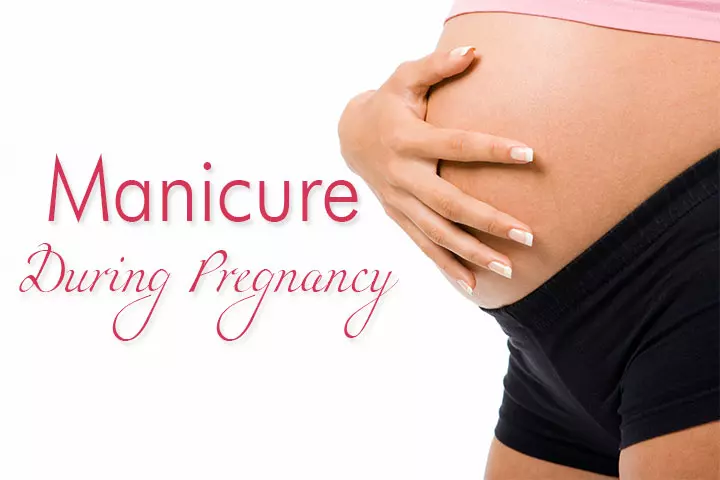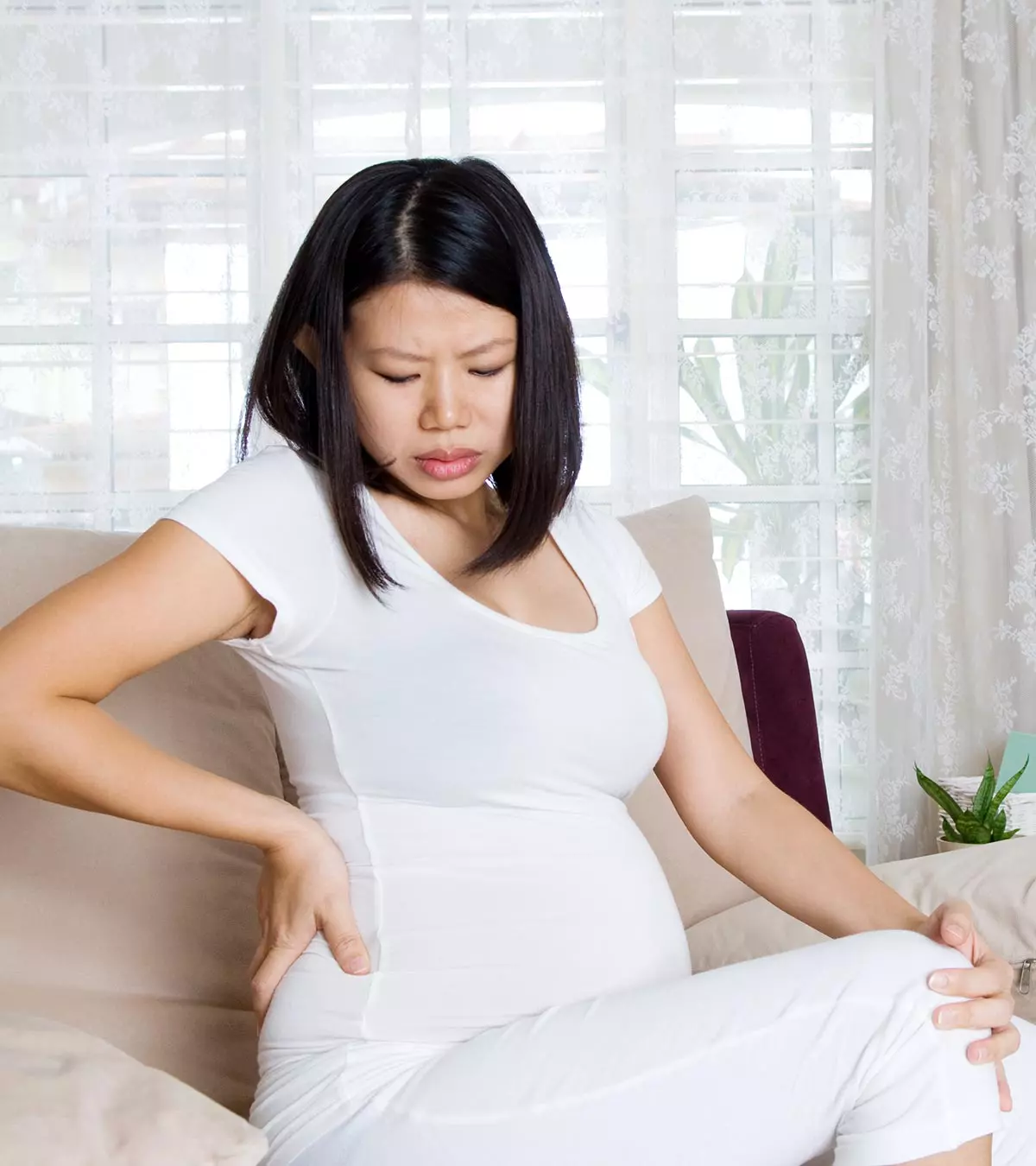
Image: Shutterstock
During pregnancy, your body is likely to undergo several changes. While some can make you happy, others can cause pain and discomfort.

One such pain is pelvic girdle pain which affects about 80% of pregnant women. The pain might impact your daily activities, and in some women might lead to a chronic condition later (1).
This post gives you insights into the causes and symptoms of pelvic girdle pain and tells you some measures to manage it effectively.
Key Pointers
- Pelvic girdle pain affects approximately 80% of pregnancies.
- The pain is commonly experienced in the pelvic region, lower back, hips, lower abdomen, groin, and vaginal area.
- The condition is often caused by the pressure exerted by the growing fetus on the pelvic bones, joints, and ligaments, as well as other factors.
- Pelvic muscle and joint changes, weight gain, and previous pelvic injuries can contribute to the pain.
- Specific exercises, using pillows for support, and taking short steps while walking or changing seating positions may alleviate pelvic girdle pain.
What Is Pelvic Girdle Pain?
The pelvis, which is the largest bone of the skeleton, is where the hip bones are situated. The pubic symphysisiA joint situated between the left and right pelvic bones that supports the body during labor. joins them at the front, and two sacroiliac jointsiA joint that forms a connection between the lower region of the spine with the pelvis. link it at the back. A strong network of ligaments surrounds these joints, keeping the bones intact.
Pelvic girdle pain (PGP) refers to the pain anywhere from the front of the pelvis to the back, buttocks or down the leg, groin, lower abdomen, inner thigh, and vaginal area. The pain can be mild to severe. Severe pain might limit your mobility.
It may begin anytime during pregnancy or when you are nearing labor. It can develop after delivery as well (2). According to the Australian Journal of General Practice, It is believed that 4–84% of pregnant women experience lower back discomfort and pelvic girdle pain.
When Does PGP Develop In Pregnancy?
- You might feel the pain during early pregnancy (or first trimester) or a few days before labor.
- There might be pain and discomfort in the later stages of pregnancy (or third trimester) as the baby moves down into the pelvic region.
- You might also feel the pain during the postpartum period (3). Keep reading to know why you experience this pain during pregnancy.
What Causes Pelvic Girdle Pain?
The primary cause of pelvic girdle pain is the low positioning of the fetus in the pelvic region. The increasing size of the fetus puts pressure on the pelvic bones, joints, and ligaments, leading to discomfort. However, the pain might increase due to a combination of factors such as (4) (5):
- Uneven movements of the pelvic joints
- Changes in the way the pelvic muscles work to support the girdle
- Abnormal functioning of one pelvic joint, which stresses the other joints
- Increasing maternal weight
- Change in the center of gravity as the fetus grows
- Pregnancy hormones affecting the connective tissues in the pelvic region
- Prior injury or trauma to the pelvic region, from an accident or a fall
- Repetitive or strenuous physical activities
- Exercise routines that strain the pelvic movements
- The position of the fetus puts pressure on the pelvic area
- History of lower back or pelvic pain
- Physically demanding work routine
So, how do you know if it is PGP and not something else?
What Are The Symptoms Of Pelvic Girdle Pain?
The location and severity of pain vary from woman to woman. The pain can only be on one side, move from one side to another, or it can be a general ache or shoot up suddenly and disappear.
The common signs and symptoms of PGP include:
- Pain in the lower back, hips, knees, groin, pubic region and thighs
- Grinding or clicking in the pelvic region
- Pain is noticeable during movements such as – walking on rough surfaces or for long distances, climbing stairs, sitting or standing for a long time, moving your knees while getting in and out of the car or a bathtub, lying on the bed in some positions and sexual intercourse
Pain might increase at night if you are active throughout the day. Symptoms may aggravate with the increasing weight of the baby and change in the center of gravity. It occurs due to the relaxin hormone, which usually softens the ligaments, allowing the pelvis to widen and make room for the baby (6).
Esay Querubin experienced severe pelvic pain a week before her expected delivery. Recalling her ordeal, she says, “I started feeling a sharp pain in my pelvis — on my pubic bone area —which I found out later is called the symphysis pubis. It started as a slight discomfort, something not to worry about as it seems normal in pregnancy. But in two days, the pain went from manageable to severe.
“It made walking, adjusting positions in bed, getting dressed, getting in and out of the car, more or less all activities which involved movement of legs, very painful. Stepping one leg forward felt like my pubic bone was being torn apart. From then on, I used a wheelchair whenever possible (i).”
During a visit to the doctor five days after her C-section, Querubin was diagnosed with symphysis pubis dysfunction.
How Is Pelvic Girdle Pain Diagnosed?
If you happen to feel any discomfort in the pelvic region, go to the doctor. The doctor will examine you thoroughly, and ask you about the origin of the pain and its severity. Provide all the relevant information about your activities or movements that may be causing the pain, so that the doctor can make the right diagnosis.
Pelvic girdle pain may be mistaken as sciatica pain. A physiotherapist can differentiate between both the conditions as they take a detailed look at the pelvic muscles and joints.
Treatment For Pelvic Girdle Pain During Pregnancy
PGP is treatable, and you can manage the pain with a few home care tips. Specific exercises and lifestyle changes can help in easing the pain and make the pregnancy better (4).
A physiotherapist usually treats pelvic girdle pain who may also administer heat treatments and relaxation techniques besides physical therapy. A brief explanation of the treatments are listed below.
- Advice on avoiding movements that aggravate the pain, best positions for resting and movement, and pacing your activities to reduce your pain.
- Exercises that can relieve your pain, and help you move comfortably. They help strengthen your pelvic floor muscles to improve your balance and make the spine stable.
- Manual therapy that includes chiropractic adjustments or manual realignment of joints is done in multiple visits until the muscles become stronger enough to hold the joints.
- Pain relief methods such as TENS (transcutaneous electrical nerve stimulation)iA technique that uses mild electric currents to stimulate nerve cells in order to treat or reduce pain.
- Hydrotherapy, which involves exercising in water, can provide relief to a certain extent.
- AcupunctureiAlternative medicine where thin needles are inserted at specific points of the body typically used to manage intense pain. from an experienced acupuncturist
- A warm bath, heat therapy and ice therapy.
- Pelvic support belts or crutches
If you have severe pain that limits your mobility, your doctor may prescribe pain medications such as paracetamol or topical analgesics or topical oils. Always consult your physiotherapist or obstetrician for effective pain management and personalized treatment. They can recommend specific exercises and interventions based on your condition.
Exercises That Help Relieve Pelvic Girdle Pain
Some exercises or yoga postures can help relieve the pain but check with your doctor before trying them. Stretching and strengthening the muscles of your lower back, hips, and quads can help (7).
- Bridge exercise: Lift your hips up by squeezing the pelvic floor and breathe out. Remain in this pose for two to three seconds, and lower the hips. Repeat.

- Hip lifts: Kneel on all fours, lift one foot upwards and back down. Repeat.
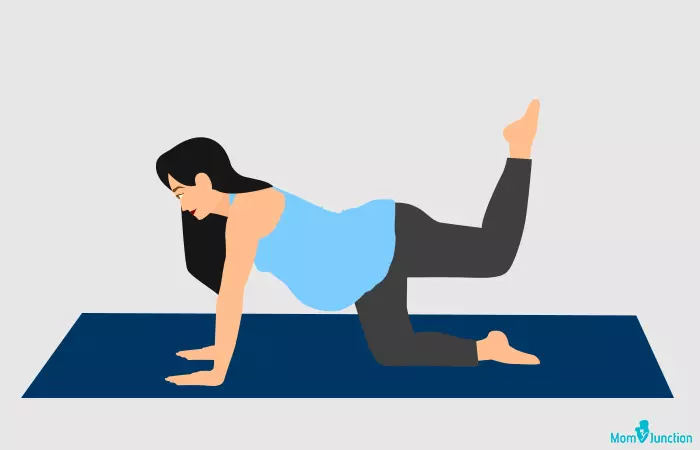
- Leg press: Lie on a side and lift the hip towards the chest. Next, push out by squeezing the pelvic floor muscles and buttocks.
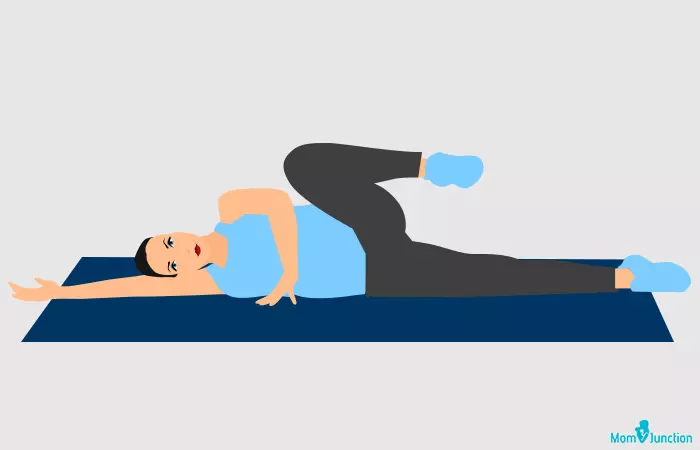
- Leg lifts: Lie on one side and lift your leg, but not too high. Bring it down slowly and involve only small movements.
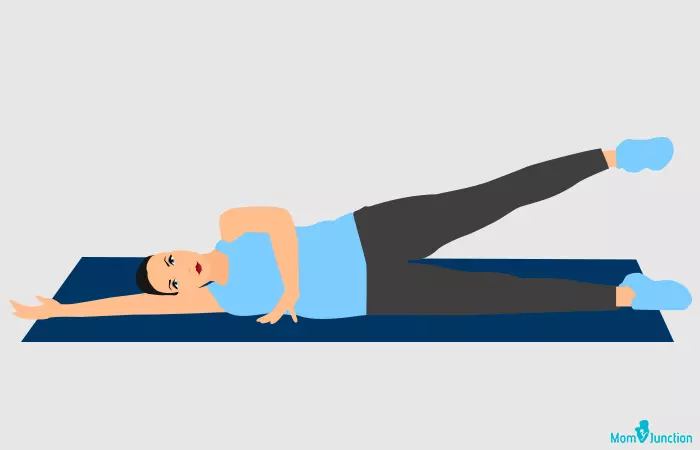
You can also do pelvic floor exercises such as pelvic tilts, kegels, cat stretch, and hip bridges. Stability ball exercises will also help.
 Be watchful
Be watchfulHow To Cope With Pelvic Girdle Pain During Pregnancy?
You can manage the pain before and after treatment, with the below measures (8):
- Stay active as much as the pain allows you to, and rest whenever possible.
- Try alternating the positions from sitting to standing during an activity.
- Sleep on a side, with a pillow to support your belly and upper leg.
- Explore different ways of climbing stairs. While using the staircase, use the pain-free leg first and then the other leg.
- Avoid activities such as bending to lift something or carrying anything, as they put stress on the pelvis.
- Indulge in safe sex positions such as kneeling on all the fours, or lying on one side.
- While walking, take shorter steps rather than longer strides.
- Avoid sitting down in a cross-legged position to maintain a safe and proper posture.
- Be alert while involving pelvic floor muscles before laughing, coughing, or sneezing.
- Use chairs that have a backrest, or use a cushion for supporting your lower back.
- Keep your knees together while getting out of the bed.
- Maintain a balanced diet to manage weight effectively.
- Use footwear with low heels and that have arch support.
- Get a prenatal massage from a specialized therapist.
Following these tips can help keep the pain away during pregnancy. That brings us to the next question.
Does Pelvic Girdle Pain Affect Your Labor?
PGP will not affect your labor in any way. But if you are apprehensive about your delivery, talk to your doctor about the birth options. They might suggest a few positions for vaginal delivery:
- Sitting upright or in a kneeling position
- Side-lying with knees or pillows against the chest
- Avoid lying down with your back
In some cases, PGP can make it difficult to open your legs up during delivery. If natural birthing is ruled out due to pain, your doctor would recommend a cesarean section.
 Did you know?
Did you know?How Soon Does Pelvic Girdle Pain Reduce?
PGP will go away within a few weeks or months after birth. The chances of postpartum pelvic girdle pain usually exist if the condition is severe during pregnancy (4).
Mild pain might recur before periods, as the hormones (estrogeniA hormone responsible for the development and functioning of female reproductive organs. and progesteroneiA female reproductive hormone that plays a vital role in menstruation, pregnancy, and breastfeeding. ) that act upon the menstrual cycle might affect as the pregnancy hormones do.
Does PGP Recur In Your Next Pregnancy?
PGP might recur in the subsequent pregnancy, but it can be managed effectively if you remain fit and healthy. Consider having a gap between pregnancies, and try to stay fit and lose weight to lessen the pelvic girdle pain.
Strengthening the abdominal and pelvic floor musclesiMuscles located at the bottom of pelvis that provide support to a woman’s bladder, bowel, and uterus. will lessen the chances of PGP in the following pregnancy.
Next, we answer some frequent queries about PGP.
Frequently Asked Questions
1. Can I get pelvic girdle pain when not pregnant?
Yes, you may develop PGP from any injury or arthritis. However, pregnant women are more prone to this condition than those who are not pregnant.
2. Are pelvic girdle pain and sciatica similar?
Pelvic girdle pain and sciatica are known to cause pain in the lower back or buttock region. Sciatica is a pain that radiates from the lower back, towards the buttocks and into one or both the feet, whereas PGP refers to pain in any part of the pelvic region to the vaginal area.
3. Can PGP cause early labor?
PGP is unlikely to cause early labor. Exercises, support belts, and some lifestyle changes will help you reach full term.
4. Will pelvic girdle pain affect my unborn baby?
No, pelvic girdle pain during pregnancy is not known to affect the unborn baby in any way (8).
5. Can I give birth naturally with a pelvic girdle?
Yes, an experienced medical team can help you have a normal delivery (10). They can guide you about comfortable positions and pain relief techniques to ensure a safe and healthy delivery.
Although common, pelvic girdle pain during pregnancy can be an uncomfortable and painful experience. Trying some effective exercises and tips on how to relieve pelvic girdle pain can come in handy. The key is to stay healthy, active, and aware of the symptoms so you can see your ob/gyn for treatment as soon as possible. Irrespective of the intensity of the pelvic pain, be it mild or severe, you must consult your doctor. They can recommend safe workouts and offer you effective measures to deal with the pain.
Infographic: Coping With Pelvic Girdle Pain During Pregnancy
Pelvic girdle pain is a common pregnancy-related concern, often caused by the pressure from your growing baby on the pelvic area. While usually mild and not a cause for concern, it can still be uncomfortable. However, you can ease the pain with simple exercises and home remedies. Dive into our infographic for effective tips to help you manage pelvic girdle pain and find much-needed relief.
Some thing wrong with infographic shortcode. please verify shortcode syntax
Are you pregnant and suffering from pelvic girdle pain? Learn more about PGP and how to manage it in this informative video!
Personal Experience: Source
MomJunction articles include first-hand experiences to provide you with better insights through real-life narratives. Here are the sources of personal accounts referenced in this article.
i. Pregnancy and pelvic pain– symphysis pubis dysfunction. https://practicalpinay.blogspot.com/2018/08/pregnancy-and-pelvic-pain-symphysis.htmlReferences
- Janneke M Bastiaanssen et al.; (2005); Etiology and prognosis of pregnancy-related pelvic girdle pain; design of a longitudinal study.
https://www.ncbi.nlm.nih.gov/pmc/articles/PMC548283/ - Pregnancy-related pelvic girdle pain and its relation to muscle function.
https://www.diva-portal.org/smash/get/diva2:355620/FULLTEXT01.pdf - Nikolaos K Kanakaris et al.; (2011); Pregnancy-related pelvic girdle pain: an update.
https://www.ncbi.nlm.nih.gov/pmc/articles/PMC3050758/ - Pelvic girdle pain (symptomatic pelvic girdle relaxation pelvic joint syndrome).
http://www.nfog.org/files/guidelines/18%20NGF%20Obst%20pelvic%20girdle%20pain%20Stuge.pdf - Pelvic Floor Muscle T elvic Floor Muscle Training in Management of Paining in Management of Postpartum Pelvic Floor Dysfunctions: A Literature Review.
https://stars.library.ucf.edu/cgi/viewcontent.cgi?referer=&httpsredir=1&article=1110&context=honorstheses - Pelvic girdle pain (PGP) is common in pregnancy.
https://www.nct.org.uk/information/pregnancy/body-pregnancy/pelvic-girdle-pain-pgp-common-pregnancy - Pregnancy-related low back pain and pelvic girdle pain (PGP).
https://www.nhs.uk/pregnancy/related-conditions/common-symptoms/pelvic-pain/ - Pelvic pain in pregnancy.
https://www.nhs.uk/pregnancy/related-conditions/common-symptoms/pelvic-pain/ - Pelvic pain in pregnancy.
https://www.tommys.org/pregnancy-information/pregnancy-complications/pelvic-pain-pregnancy - Pelvic girdle pain and pregnancy
https://www.rcog.org.uk/for-the-public/browse-our-patient-information/pelvic-girdle-pain-and-pregnancy/
Community Experiences
Join the conversation and become a part of our nurturing community! Share your stories, experiences, and insights to connect with fellow parents.
Read full bio of Dr. Anita Gondy
Read full bio of Rebecca Malachi
Read full bio of Swati Patwal
Read full bio of Aneesha Amonz















